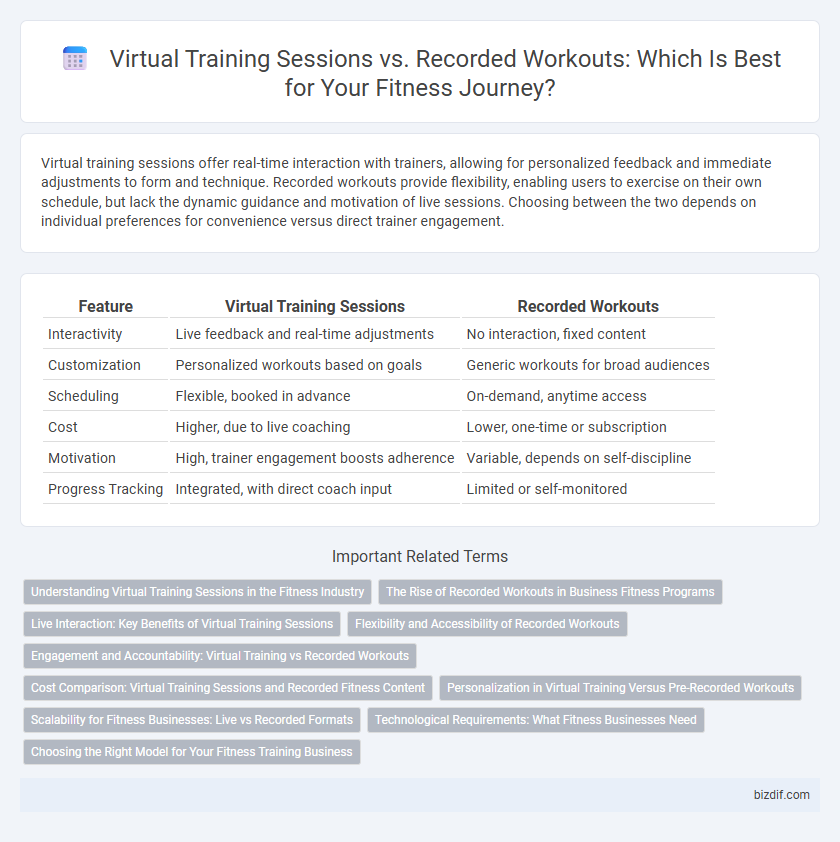Virtual training sessions offer real-time interaction with trainers, allowing for personalized feedback and immediate adjustments to form and technique. Recorded workouts provide flexibility, enabling users to exercise on their own schedule, but lack the dynamic guidance and motivation of live sessions. Choosing between the two depends on individual preferences for convenience versus direct trainer engagement.
Table of Comparison
| Feature | Virtual Training Sessions | Recorded Workouts |
|---|---|---|
| Interactivity | Live feedback and real-time adjustments | No interaction, fixed content |
| Customization | Personalized workouts based on goals | Generic workouts for broad audiences |
| Scheduling | Flexible, booked in advance | On-demand, anytime access |
| Cost | Higher, due to live coaching | Lower, one-time or subscription |
| Motivation | High, trainer engagement boosts adherence | Variable, depends on self-discipline |
| Progress Tracking | Integrated, with direct coach input | Limited or self-monitored |
Understanding Virtual Training Sessions in the Fitness Industry
Virtual training sessions in the fitness industry offer real-time interaction between trainers and clients, enabling personalized feedback and immediate adjustments to workouts. This live format enhances motivation and accountability through direct communication and scheduled sessions. Unlike recorded workouts, virtual sessions provide dynamic customization to meet individual fitness goals and accommodate varying skill levels.
The Rise of Recorded Workouts in Business Fitness Programs
Recorded workouts have surged in popularity within business fitness programs, offering employees flexible access to diverse exercise routines anytime, enhancing engagement and consistency. These sessions enable companies to scale wellness initiatives efficiently while accommodating varying schedules and fitness levels. The integration of recorded content with analytics tools allows for personalized tracking of participant progress, driving measurable health outcomes.
Live Interaction: Key Benefits of Virtual Training Sessions
Virtual training sessions provide real-time feedback and personalized guidance that recorded workouts cannot match, enhancing exercise form and reducing injury risk. The live interaction fosters motivation and accountability through direct communication with trainers and peer support. This dynamic environment adapts instantly to individual needs, optimizing workout effectiveness and overall fitness progress.
Flexibility and Accessibility of Recorded Workouts
Recorded workouts offer unparalleled flexibility and accessibility, allowing users to exercise anytime and anywhere without syncing to live schedules. These sessions cater to diverse fitness levels and preferences, providing on-demand access to a wide range of workouts from yoga and HIIT to strength training. The ability to pause, rewind, or repeat exercises enhances personalized pacing and ensures consistent progress regardless of time constraints or location.
Engagement and Accountability: Virtual Training vs Recorded Workouts
Virtual training sessions provide real-time interaction with trainers, enhancing engagement through personalized feedback and immediate motivation. Recorded workouts lack live accountability, often reducing commitment and consistent effort. The dynamic nature of virtual sessions fosters a stronger sense of responsibility crucial for sustained fitness progress.
Cost Comparison: Virtual Training Sessions and Recorded Fitness Content
Virtual training sessions often involve real-time interaction with fitness professionals, resulting in higher costs averaging $30 to $60 per session due to personalized guidance. Recorded fitness content typically offers a more affordable option, with monthly subscriptions ranging from $10 to $25, providing access to a broad library of workouts without direct instructor feedback. Evaluating the cost effectiveness depends on individual preferences for customization and budget flexibility in fitness training.
Personalization in Virtual Training Versus Pre-Recorded Workouts
Virtual training sessions offer real-time feedback and tailored adjustments to exercise form and intensity, enhancing personalization beyond the fixed structure of recorded workouts. Trainers can modify routines based on immediate performance and individual goals, ensuring a dynamic and responsive fitness experience. Recorded workouts provide convenience but lack the interactive customization that virtual sessions deliver, limiting their effectiveness for diverse fitness levels.
Scalability for Fitness Businesses: Live vs Recorded Formats
Virtual training sessions offer real-time interaction and personalized feedback, making them ideal for smaller client groups but challenging to scale without proportional increases in trainer availability. Recorded workouts provide a scalable solution by allowing unlimited client access without additional trainer time, enabling fitness businesses to expand reach and revenue efficiently. Balancing live engagement with the scalability of recorded content is critical for optimizing growth in fitness enterprises.
Technological Requirements: What Fitness Businesses Need
Fitness businesses need reliable high-speed internet, quality cameras, and microphones to deliver seamless virtual training sessions, ensuring real-time interaction and personalized feedback. Recorded workouts require robust video hosting platforms and user-friendly apps for on-demand access, focusing more on storage and streaming capabilities than live connectivity. Both approaches demand investment in cybersecurity measures to protect client data and maintain trust.
Choosing the Right Model for Your Fitness Training Business
Virtual training sessions offer real-time interaction and personalized feedback, enhancing client engagement and motivation in fitness training businesses. Recorded workouts provide flexibility and scalability, allowing clients to exercise at their own pace while reducing the need for constant trainer availability. Selecting the right model depends on target audience preferences, business goals, and resource allocation to optimize client retention and satisfaction.
Virtual Training Sessions vs Recorded Workouts Infographic

 bizdif.com
bizdif.com